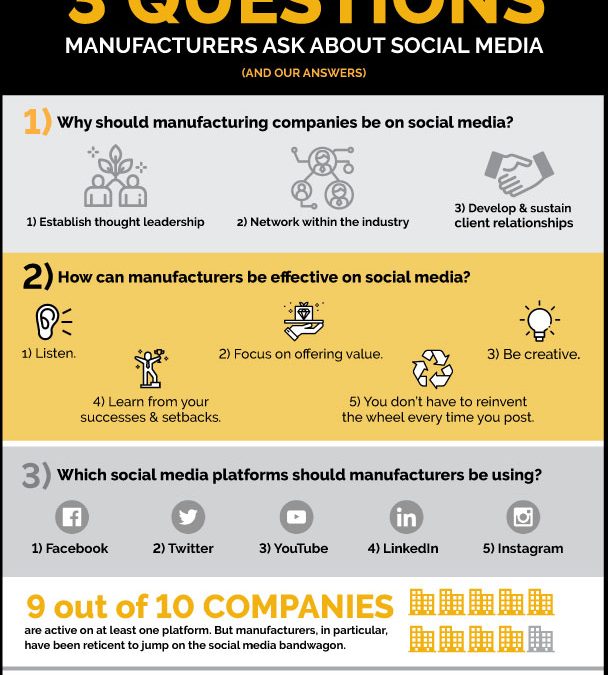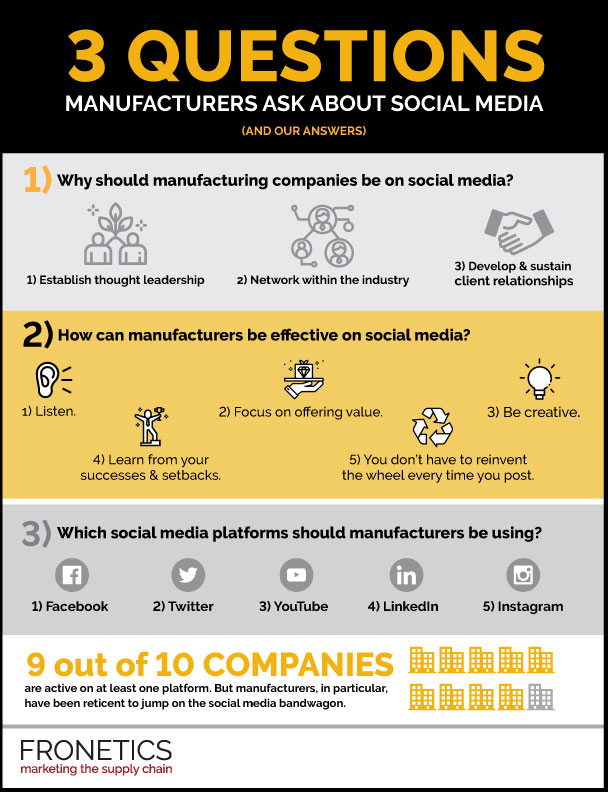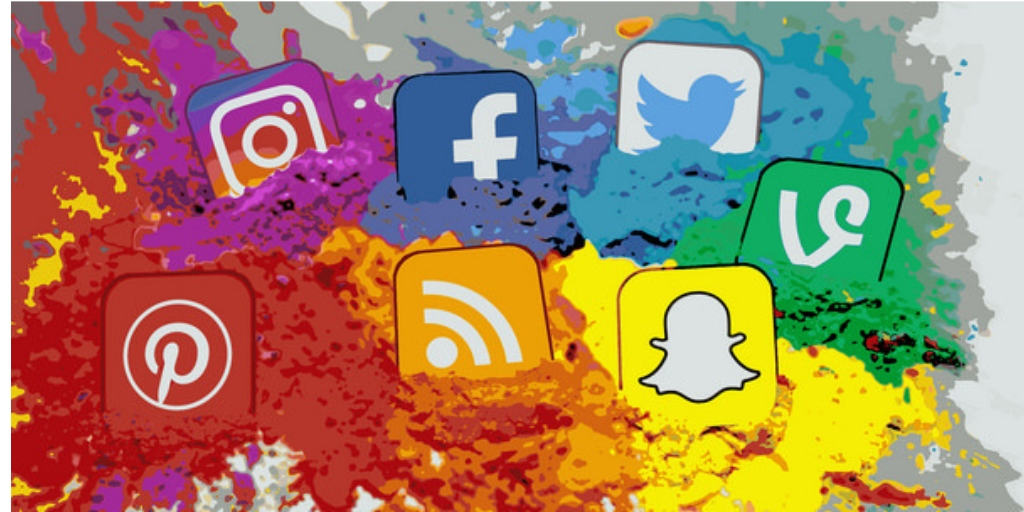
by Fronetics | May 1, 2019 | Blog, Content Marketing, Logistics, Manufacturing & Distribution, Marketing, Social Media, Supply Chain
We get many queries from manufacturers about social marketing — mostly, why and how should I use it — so here are our answers to the most-popular questions manufacturers ask about social media.
Highlights:
- Facilitate networking opportunities, thought leadership, and prospect/client relationships.
- Consider using popular platforms like YouTube and Instagram to engage users and drive website traffic.
- Don’t use social media to push your products.

(Made with Canva)
B2B operations have increasingly embraced social media as a strategic marketing tool. In fact, 9 out of 10 companies are active on at least one platform. But manufacturers, in particular, have been reticent to jump on the social media bandwagon.
If your manufacturing operation isn’t making use of social media as a tool to engage with your audience, you’re missing out on big lead generation potential. Manufacturers like the Dow Chemical Company, ArcelorMittal, and CAT Products are among those that have figured out how to harness the power of social media.
To help you launch or refine your efforts, we’ve put together the following answers to the most-popular questions manufacturers ask about social media.
Why should manufacturing companies be on social media?
There are three major reasons that manufacturing brands should be all over social media:
- Establish thought leadership
- Network within the industry
- Develop and sustain client relationships
Notice that none of these involve selling products. As with content marketing in general, good social media marketing isn’t about pushing your products.
[bctt tweet=”The value of social media for manufacturers is in its potential to establish and expand thought leadership and to cultivate meaningful and fruitful relationships within your industry and among prospects and clients.” username=”Fronetics”]
To make the most of social media as a marketing tool, abandon the idea that it’s about blatant sales pitches. Instead, approach it from the perspective that it’s an inherently social tool – that is, its value for manufacturers is in its potential to establish and expand thought leadership and to cultivate meaningful and fruitful relationships within your industry and among prospects and clients.
Which social media platforms should manufacturers be using?
Not all social media platforms are created equal. Each requires its own strategy, content format, and media. We recommend that manufacturers consider these five platforms:
1) Facebook
Facebook is an excellent place to share content with a wide segment of your audience, to promote engagement (through likes, comments, and shares), and to engage with peers and prospects. Not only that, the savviest marketers are using Facebook to understand their industry better – everything from strategies of peer brands to a fuller picture of your target buyer persona to the informational or product needs of your prospects.
2) Twitter
Twitter’s format is about brief, pithy content, used to engage with and inform your audience. This is an ideal place to let customers know what you’re planning next, to establish your corporate personality, and to let your audience in on a slice of your day-to-day operations and values.
3) YouTube
Video marketing for manufacturers is skyrocketing. With video being the most popular form of content online today, YouTube is an obvious choice for marketers. Whether it’s “how to” videos, footage of your operations, or interviews with subject-matter experts, your brand should be using YouTube to drive search traffic and educate prospects.
4) LinkedIn
B2B marketers unequivocally rank LinkedIn as the most effective network for lead generation, follower engagement, and traffic to their websites. An ideal place to engage with industry leaders, LinkedIn is also great for distributing content to a focused audience.
5) Instagram
The popularity of this highly visual platform has continued to skyrocket – it’s currently the second-most-used social media platform (up from fourth just two years ago). And believe it or not, this picture-based network is a powerhouse for B2B brands. We’ve written extensively about how brands can leverage Instagram and Instagram Stories. Suffice it to say, this is a perfect place to post your most engaging visual content and actively engage with followers.
How can manufacturers be effective on social media?
As with any content marketing effort, a well-thought-out social media strategy is a big part of success. As you create and begin to implement your strategy, start with these five tips.
1) Listen.
Before you post even a single piece of content, start by listening to your audience. In the days before social media, marketers had it much harder when it came to determining audience needs and preferences. Use these platforms to research your target prospects, as well as how competitors are engaging followers. Make note of the questions your target audience has, frustrations or challenges they express, and what types of content they engage with.
2) Focus on offering value.
You’d be surprised how many manufacturers neglect to place a premium on simply being useful with their social media content. It’s not complicated: If you post relevant, valuable content for your target audience, you’ll boost engagement, grow brand awareness, and generate and convert more leads.
3) You don’t have to reinvent the wheel every time you post.
One of the great things about social media is that it rewards not only content creation, but content curation. While you do want to be posting original content most of the time (experts recommend about 60%), a good chunk of your posting activity should include curating relevant content from third parties to share with your followers.
4) Be creative.
Separating yourself from your competitors can be a challenge, but it’s one worth striving toward. Start by asking yourself what makes your operation unique, what’s special about your process, what industry-leading expertise does your executive team have, what unusual perspective can you offer? Next, start breaking these four rules.
5) Learn from your successes and setbacks.
There are many tools out there to help you track the results of your social media efforts. Determine the right KPIs for your business and keep track of your results relentlessly. These metrics will allow you to study your impact and frequently tailor your strategy accordingly.
It’s time for manufacturers to fully embrace the marketing potential of social media. Whether you create and implement your own strategy, or decide to outsource your social media efforts, social media is a powerful set of tools that manufacturers should be harnessing.
Are there other questions manufactures ask about social media that we missed? Let me know in the comments.
Related posts:


by Fronetics | Apr 30, 2019 | Blog, Current Events, Marketing, Social Media, Video Marketing
Also, this month in social media news: LinkedIn adds a “Teammates” option to facilitate connections among colleagues, and Facebook is testing a Stories-like newsfeed.
Highlights:
- Facebook is giving users increased access to what information advertisers have on them.
- Instagram is considering joining Facebook in promoting communal video experiences.
- LinkedIn’s “Teammates” feature helps users prioritize content from close connections.
This month in social media news, Facebook is continuing to combat user privacy concerns by introducing a tool to provide greater transparency about the content they see on their Newsfeeds, both from connections and from advertisers. The platform is also continuing to explore the Stories trend, as it conducts early-stage testing of a layout that resembles the Stories feature more than it does the existing Newsfeed.
Both Instagram and LinkedIn are promoting greater community among users. Instagram is testing a group video viewing option, joining Facebook’s Watch Party, introduced last year. LinkedIn is rolling out a feature which allows users to prioritize content from their closest connections. Read on for a round-up of social media news.
Facebook Introduces a Feature to Assist Users in Understanding the Context of Content Appearing on the Newsfeed
Having been embroiled in ongoing privacy-related scandals, Facebookis making users’ safety and comfort using the platform a priority. To that end, the company has announced that it will be giving users greater control over the content that appears on their Newsfeeds, through the “Why am I seeing this post?” feature.
[bctt tweet=”Facebook has announced that it will be giving users greater control over the content that appears on their Newsfeeds, through the “Why am I seeing this post?” feature.” username=”Fronetics”]
In 2014, the social media giant launched its similar feature, “Why am I seeing this ad?” which was geared toward projecting transparency in the company’s embattled relationship with users and their advertising content. Facebook announced simultaneously that it will be “making improvements” to the older feature. The new “Why am I seeing this post?” feature aims to help users understand the context for what shows up in their Newsfeeds, and it also allows them to control and manage content.
Marketers should be aware that users will now be able to find out when their profile information matches with the information on an advertiser’s list, as well as when an advertiser “saves their personal information in their database and other details such as if they (the users) were targeted by the advertiser through another marketing partner of theirs (advertisers).”
Instagram Tests a Communal Video Viewing Option
Social media platforms are continuing to push the boundaries of social experiences that are possible for users not in physical proximity. Back in 2018, Facebook rolled out its “Watch Party” option, and now Instagram is exploring jumping on the bandwagon, testing a similar function in its app.
The feature would allow users to view video content on Instagram with a friend, while simultaneously seeing their reactions on screen, using the phone’s camera, in a split-screen view. Users can also apply face filters and other visual tools to the personal feed. Instagram and Facebook’s features are part of a larger trend toward “multi-participatory consumption.”
LinkedIn Adds a New “Teammates” Option to Maintain Connections Among Colleagues
In an ongoing attempt to boost on-platform engagement, LinkedIn has introduced a new feature called “Teammates.” It enables users to put a priority on updates from immediate connections, content with which LinkedIn has found that its users are 60% more likely to engage than more distant connections. As users place a priority on updates from teammates, it will appear higher in their feeds.
The network is pushing the feature as promoting community within the workplace: “95% of working professionals think it’s a good idea to have friends at work, and 63% say they have relationships with their co-workers outside the office. Based on a recent study we shared last month, having friends at work can also help you advance your career.”
Marketers should take note, since it’s not immediately clear what the impact of this feature will be on branded content. Nonetheless, it emphasizes the value of cultivating meaningful connections on the platform, as potential clients will be more likely to mark these types of connections as “teammates,” placing a higher priority on their content.
Facebook is Testing a Stories-Like Swipeable Newsfeed
Stories features across the social media landscape continue to grow in popularity. In keeping with the trend, Facebook is experimenting with a Newsfeed layout which allows users to side-scroll or swipe between posts in their feed, rather than scrolling down. This is a potential significant re-design for the platform, and points to the fact that the Stories trend is here to stay.
If Facebook adopts the design, it would merge Stories and Newsfeed content into a single stream. The network emphasized to TechCrunchthat it is “in the very early stages of development,” and “still needs to conduct a lot more user research before any public experimentation can take place.”
Therefore, while it’s unlikely that a new Newsfeed is coming soon, what is clear is that social media platforms are experimenting with increasingly integrating Stories-style content into every aspect of the user experience.
Related posts:


by Fronetics | Apr 10, 2019 | Blog, Logistics, Marketing, Social Media, Supply Chain
We want to hear from you!
The supply chain and logistics industries may have taken longer to jump into the social media game, but those companies that are leveraging these platforms are seeing positive effects on their business.
An industry survey conducted by Fronetics found that while 100% of respondents have used social media for five years or less (36% for one year or less), more than two-thirds (68%) have already realized results. That begs the questions: which networks are they on? What’s working? What’s not?
Fronetics is, once again, conducting a survey on social media use within the supply chain and logistics industries to help answer these questions – and to determine if changes have taken place since the previous survey. That’s where you come in: we need your help to get the latest information on how companies like yours are using social networking for business purposes.
If your company is part of the logistics or supply chain industries, you are invited to take the survey. It should take less than 5 minutes of your time. Responses will be reported in aggregate, and no identifiable information (individual or company) will be shared with anyone.
Responses are due May 31, so act now so your voice is heard. Provide your email address, and we’ll share the results so you can see how your company compares to the industry at large.

Please contact [email protected] with questions.

by Fronetics | Mar 28, 2019 | Blog, Content Marketing, Current Events, Logistics, Marketing, Social Media, Supply Chain
Also, this month in social media news: Twitter launches new camera tools to increase visual focus; and Pinterest introduces Catalogs and expands shopping ads.
This month on social media news, we’re seeing a few trends continuing. Platforms are increasingly offering robust analytics tools to content creators in an effort to boost engagement. This time, it’s Twitter rolling out a new tool that gives video publishers insights on optimal post timings. Twitter is also jumping on the “Stories” bandwagon, with its own answer to the trend: a camera feature that allows users to create images similar to Instagram and Facebook Stories.
Also this month, we’re seeing good news for brands when it comes to advertising on social media. Facebook is introducing a feature for premium video advertising, while Pinterest is rolling out multiple tools to help brands sell directly from the platform. Read on for a round-up of social media news.
Social media news for March 2019
Twitter Debuts a New Analytics Tool for Video Publishers
In an effort to provide video publishers with increased data to aid in performance improvement on Twitter, the platform has released the first in a new series of publisher insights tools: Timing is Everything. According to Twitter, the tool “displays historical data showing when audiences are on Twitter watching and engaging with video. This data highlights the best time(s) to Tweet video content with an aim to maximize engagement, conversation, and viewership.”
This is big news for video publishers, including content marketers. Twitter is offering key insights on one of the most important factors in determining social media marketing success: timing. Of course, increased engagement is in the platform’s best interest — and it’s in yours as well. Stay tuned for the release of more insight tools from Twitter in the coming weeks and months.
Facebook Announces Facebook Showcase for Premium Video Advertising
Facebook has debuted Facebook Showcase, a new premium video ad program that gives online video and TV ad buyers participating in the upfront selling cycle new opportunities to reach their target audiences on the platform. Showcase is currently available for campaigns targeting U.S. audiences and includes In-Stream Reserve, In-Stream Reserve Categories, and Sponsorships.
Facebook’s announcement is another big one for advertisers. Showcase will help advertisers connect with people through premium content and unique video experiences and can help reach younger-skewing audiences that are increasingly difficult to reach on TV.
Twitter Launches New Camera Tools to Increase Visual Focus
While platforms like Facebook and Instagram are increasingly ushering users towards their respective Stories features, Twitter is introducing a camera tool which will let users capture Stories-like images, including overlays and a searchable element. In addition to bringing the platform on board with the Stories trend, it ushers in more visual content options.
[bctt tweet=”Twitter is introducing a camera tool which will let users capture Stories-like images, including overlays and a searchable element.” username=”Fronetics”]
Swiping left on your Twitter timeline from your mobile device will take you to the new camera. There you can capture an image or video, or even go Live straight from Twitter, rather than having to be routed through Periscope. Next, users have the option to add details to the image, including hashtags suggested based on location. Stickers and filters aren’t here yet, but no doubt they’ll be coming soon.
Pinterest Introduces Catalogs and Expands Shopping Ads
Pinterest has rolled out a series of new tools and products to help brands sell their products directly on the platform. The company has debuted Catalogs, which allows brands to upload their full product portfolios to Pinterest and easily turn each item into dynamic, shoppable product pins. In addition, Pinterest has introduced personalized shopping recommendations for style, home, beauty, and DIY boards.
The platform’s rollouts are good news for brands and speaks to the company’s pro-business corporate mindset: “People come to Pinterest in a shopping mindset open to discovering products, which creates a great connection between Pinners and businesses. Pinners are looking for inspiration, and brands help make that inspiration a reality.”
What other social media news has your attention this month?
Related posts:


by Fronetics | Mar 13, 2019 | Blog, Marketing, Social Media
New reports show an overall decline in social media use. With dropping numbers, why should businesses continue to use social media use? Here’s seven reasons why your brand still needs social media.
Highlights:
- Social media usage has seen a steady decline in usage over the past two years.
- Having a presence on social media shows that your business is current, approachable, and interested in meeting their customers where they are. In fact, it is often more noticeable when a business does NOT have social media accounts than when they do.
- Success should be determined when a marketing strategy delivers against business goals, where social media is a part of the overall strategy. It is a classic case of the whole being greater than the sum of the parts.
Marketers have been speaking anecdotally about the decline of social media for a solid year, but now we have data to support our instincts. The Infinite Dial 2018 report, which explores consumer usage of media and technology, has found that for the first time ever, both Facebook and Twitter use declined in 2018, from 67% to 62% and 23% to 21%, respectively. Overall, social media usage has decreased from 80% in 2017 to 77% in 2018. To put that in perspective, social media usage has increased an average of 7.77% over the last 9 years. Experts predict that we will likely see continued decline in 2019.
So, given those statistics and predictions, why should businesses continue to use social media? In a saturated market with declining audience interest, what’s the point?
Here are seven reasons why social media is still worth your time and effort
1. It’s expected.
Much like consumers expect any company worth doing business with to have a well-thought out, updated, user-friendly website, they also expect to be able to find them on social media. Having a presence on social media shows that your business is current, approachable, and interested in meeting their customers where they are. In fact, it is often more noticeable when a business does NOT have social media accounts than when they do.
2. It’s a branding tool.
Social media allows consumers who otherwise wouldn’t know about your business to discover it and learn what it’s all about. Consistently publishing to social media results in your brand remaining top of mind when a potential buyer is looking for your product or services.
3. It’s a way to build authority.
Social media isn’t just a way to tell consumers about your brand; it’s a way to show your audience that you know what they care about, what resonates with them, and that you are a trusted source of information.
4. It boosts organic visibility.
The keywords used in social media and the backlinks acquired send signals to search engines that your content is relevant for a certain subject. According to Search Engine Journal, “Google has repeatedly said that social media likes, favorites, shares, backlinks, etc. are not direct ranking signals — but there is a correlation between social media activity/popularity and how/why it is ranked by search engines.”
5. It allows for easy communication.
Whether it’s to network with industry professionals, provide customer service, or influence potential customers, social media provides a free, easily accessible way to do so. And more and more customers are expecting to be able to communicate via social media with brands.
6. It builds your brand’s reputation.
All of the above reasons factor into your brand’s reputation. By delivering resources and information to customers and potential customers, providing great customer service, increasing your visibility, and being authentic and transparent, your brand is building up an online reputation that can impact your company’s future.
7. It provides an avenue for thought leadership and acts as a distribution channel.
You’ve invested plenty of time and resources creating thought-provoking content on your website, but if you don’t share that through social media channels, how many people will find it? Social media provides an avenue for your content to be distributed and, better yet, shared with networks that you wouldn’t have had access to otherwise.
The question remains, how do we measure social media success? What does success look like?
Unfortunately, many brands fall into the trap of trying to associate an increase in sales with their social media efforts. However, more and more, marketers are realizing that this is a flawed view of what social media is all about.
We have stated before that social media should be measured in terms of potential, rather than dollar amount. A recent article on CMS Wireinterviews several professionals who agree: “Alban, the founder of Your Virtual Assistant Service, said the focus of social media should not be on ROI but on growing your following to increase brand awareness, engaging with your customers to create raving fans, and educating your potential customers about the benefits of your product.” The article continues, “Social media may or may not lead to an increase in sales, but it will give you the opportunity to build relationships with your audience and deliver ‘amazing’ customer service.”
Likewise, Ben Ricciardi, CEO of the full service agency Times10, explains , “’There is no easy way to financially quantify what each social media interaction is worth. It’s much more effective to take all the marketing channels you’re budgeting for and compare it against the general lift or decline you see in sales.”
[bctt tweet=”Success, therefore, should be determined when a marketing strategy delivers against business goals, where social media is a part of the overall strategy. ” username=”Fronetics”]
Success, therefore, should be determined when a marketing strategy delivers against business goals, where social media is a part of the overall strategy. It is a classic case of the whole being greater than the sum of the parts. Vanity metrics — such as likes, follows, reach and engagement — are still important to help measure brand awareness and brand loyalty. However, given the overall decline in social media usage, these metrics must be taken with a grain of salt.
Social media is an important component of a complete marketing strategy. Despite recent declines in its use, there are still an estimated 2.77 billion people on social media worldwide. Nowhere else can you as quickly, easily, and cheaply have access to your audience. And most importantly, your audience expects you to be there.
Related posts:







